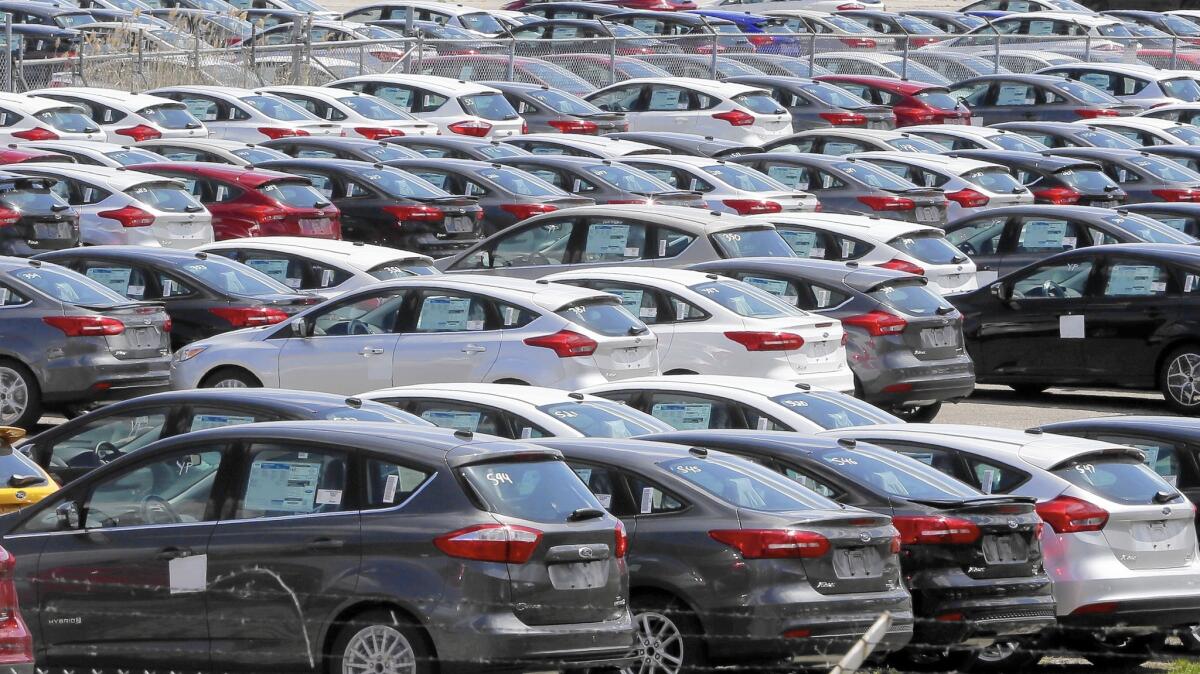2015 U.S. auto sales on track to hit a record

- Share via
Through half of 2015, auto sales are on track to hit record levels not seen in 15 years — which has many observers convinced the industry will see sales fall soon.
After climbing more than 4% through July, after several years of post-recession growth, annual sales could approach the previous annual record of 17.4 million.
The robust market has been fueled by the need for drivers to replace aging cars, historic low interest rates and sagging gasoline prices, trends expected to wane.
“This is a cyclical industry, and there is no escaping the consumer cycle,” said Steven Szakaly, chief economist for the National Auto Dealers Assn.
Sales, which hit 8.5 million so far this year, could tick up a bit next year. But they are likely near their peak, according to association forecasts.
With auto sales making up one of the strongest segments of still-tepid economy, any reversal would be felt nationally. In previous down cycles, automakers have resorted to profit-killing price wars to maintain market share and keep factories humming. With the deep recession still in recent memory, they might resort to cutting shifts and laying off workers more quickly.
Consumers — who are paying record prices for cars now — would likely see the return of big discounts.
John Hoffecker, a vice chairman at AlixPartners and head of the firm’s global automotive practice, predicts a downturn after 2016 with sales tumbling as low as 14 million.
“We have had a great run,” he said, but the end is near. In prior cycles, demand for cars has been driven by job and income growth, consumer confidence, the stock market and interest rates. But new demographic trends could also put the brake on auto sales.
The number of miles driven per car has flattened, a trend that slows car replacement, he said. During the recession, people delayed purchases for economic reasons and discovered their vehicles held up. Now, the average age of vehicles on U.S. roads is more than 11 years.
Further, the U.S. population is aging, and as people retire, they give up daily commutes and have less need for vehicles, he said.
At the same time, younger people are gravitating to urban centers with mass transit and supplementing their transportation needs with Uber, Lyft and similar “ride-sharing” services, which are essential cheaper taxis, summoned through smartphone apps. Others are using car sharing services such as Zipcar and Getaround for hourly or daily rentals.
The consulting firm estimates that each vehicle dedicated to car sharing replaces sales of 32 new and used cars. As car sharing grows in popularity, it could displace about 1.2 million purchases through 2020, according to AlixPartners estimates.
Meanwhile, cyclical economic shifts will still affect car sales.
Hoffecker expects interest rates to start to increase in the coming year. Just a tick up of 1 percentage point — for example, from 3% to 4% — slices about $1,000 from the purchasing power of consumers.
The fate of the auto industry has serious implications for the U.S. economy, said Lindsey M. Piegza, an economist at the Stifel Nicolaus & Co. investment house.
By the end of this year, auto sales will have grown almost 65% from their low of 10.4 million in 2009. Just a leveling of auto sales “will take some out of the steam out of the recovery,” Piegza said. “And if we see consumers are starting to pull back, it would be a problem.”
With discipline, automakers should be able to weather a downturn. But there’s no guarantee the industry will act rationally as sales fall, analysts said.
Consumer paid an average price of $30,452 for a new vehicle in June, according to J.P. Power, an industry research company, and it won’t take much to start a price war.
When sales dip, auto factories churn out cars at a faster rate than they can be sold, creating surplus inventory that has to be sold at discount. Automakers were slow to turn of the spigot in past downturns, Hoffecker said.
“What will the manufacturers do this time?” he asked. “Will they hold pricing or start a price war to hold onto market share?”
Industry executives, including Mike Jackson, chief executive of AutoNation, the nation’s largest dealer group, and Bob Carter, who heads Toyota’s sales in the U.S., said they would be most comfortable with an auto sales market about where it is now, and could live with it falling back into the 16-million range.
Jackson said such a “sustainable” sales rate is best for industry. Carter said he would become concerned if sales approached 18 million because that’s likely to steal business from future years and create a downturn.
For now, no one is complaining. The combination of strong sales and high transaction prices adds up to about $206 billion in consumer spending on autos through the first half of this year, $11.6 billion more than the previous record set in the first half of last year, according to J.D. Power.
Twitter:latimesjerry







